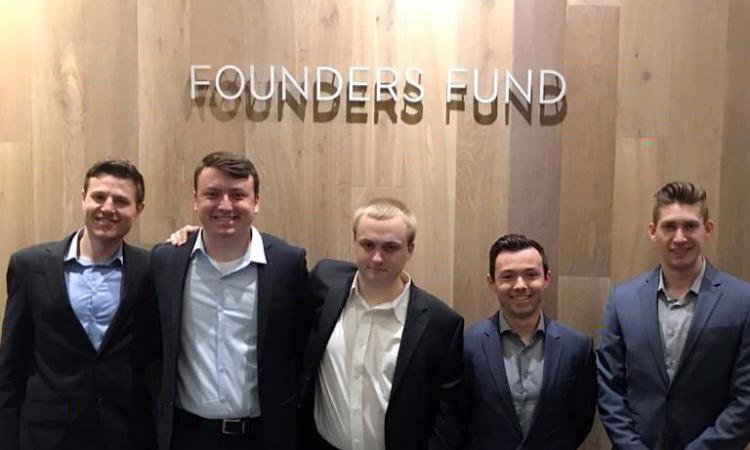Students compete in national Hacking for Defense contest

From left, team members included Trevor Stanley, Chris Coffey, Will Shand, Cory Cranford and Gerano Montoya.
CU Boulder students were among only six universities invited to present an innovative network security concept in June as part of Starts H4D, a pitch competition for cutting-edge national security solutions.
The group presented at Founders Fund, a leading venture capital firm in San Francisco, alongside teams from Stanford, University of Southern California and Duke on projects ranging from image recognition of drones, GPS jammer detection, innovative learning platforms and IoT security.
The CU Boulder team included computer science graduate student Trevor Stanley, Leeds School of Business student Chris Coffey, applied mathematics master’s student Will Shand, Technology, Cybersecurity and Policy program master’s student Cory Cranford, and mechanical engineering master’s student Gerano Montoya.
Their team, CharIoT (Characterizing the Internet of Things), developed a new machine learning approach for identifying different kinds of internet-enabled devices on a network.
Here, Trevor Stanley shares his takeaways from the class and competition:
The national Hacking for Defense program, sponsored by the National Security Innovation Network, was renamed Designing for Defense at CU Boulder because of the emphasis our mentors placed on understanding first principles, making sense of extremely ambiguous and at times complex problems, and creating original solutions.
I participated in a hackathon hosted by NSIN (formerly called MD5) last year and immediately applied for next year’s Designing for Defense course. I specifically set out to expand my knowledge and experiences through the course and felt empowered to take leadership on developing a solution to a real-world problem given to our team by the National Security Agency.
Our inclusive team of computer science students, applied math students and business students was committed to developing an effective and innovative solution for characterizing Internet of Things device traffic on a network, which could become invaluable for protecting military and healthcare networks.
Effective teamwork and communication was the biggest challenge and resource for our team. Over the semester our team dynamic and collective understanding of the NSA’s problem evolved. Helping the technical students and the business students communicate effectively with one another was incredibly rewarding for me personally, as I was able to draw on the skills I had developed while working on the Technology to Market team in my research group.
As a team, we were able to further develop our ability to respectfully debate, challenge each other’s opinions, communicate, collaborate, and effectively execute on work that was essential to our mission. For instance, our team was the only one among the other seven that raised $700 in seed funding, formed a company, created over 80 datasets, and conducted over 80 interviews with industry and government experts.
After winning the final competition between other CU Boulder teams working with various Department of Defense sponsors, our team decided to continue our project beyond the classroom.
We applied for the national Hacking for Defense competition, Starts H4D, co-sponsored by Founders Fund and NSIN in the heart of Silicon Valley.
I was humbled and inspired by the innovative solutions developed by the other teams and shared in the collective zeal for civilian service. CharIoT is a truly unique opportunity to continue adding value to the defense community as civilians, and we’ll continue this form of national service by utilizing the resources we gained from Starts H4D to further develop our IoT security solution.

